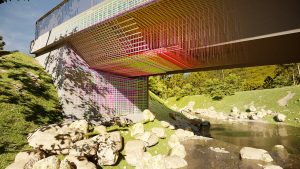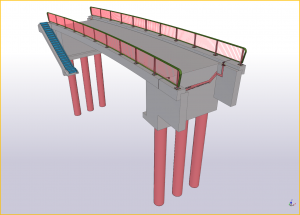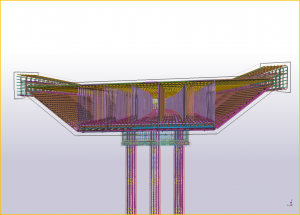Most na rzece Wertach

| Categorie | Infrastructurele projecten |
|---|---|
| Jaar | 2022 |
| Land | Poland |
| Organisatie | PMJ Structural Engineering Sp. z o.o. Sp.k. |
| Auteur | PMJ Structural Engineering Sp. z o.o. Sp.k. |
| Plaats van constructie | Niemcy, Göggingen |
| Tags |
Most jest budowlą żelbetową, jednoprzęsłową, o rozpiętości 18,5 m i szerokości 5,30 m. Przęsło mostu musiało swój kształt w rzucie dopasować do łuku drogi. Kąt krzywizny wynosi 100 stopni. Z powodu zakrzywienia przekrój poprzeczny płyty jezdnej musiał zyskać jednostronne nachylenie 2,5 %. Przy takich skomplikowanych uwarunkowaniach geometrycznych pomogło opracowanie rysunków szalunkowych poprzez modelowanie 3D.
Podpory mostu opierają się na palach wierconych o średnicy 88 cm. Dokładne usytuowanie pali w rzucie zapewnione jest poprzez szablony z niezbrojonego betonu. Podpory mają charakter skrzynkowy i składają się ze ścian żelbetowych o stałej grubości 1,50 m.
Przęsło stanowi płyta żelbetowa o stałej wysokości konstrukcyjnej 1,15 m. Pocienienia boków płyty do grubości 25 cm na końcu wspornika ukształtowano w formie „rybiego brzucha”, aby w przypadku powodzi zapewnić optymalne warunki opływu konstrukcji. Przeguby żelbetowe przenoszą obciążenia z przęsła na podpory.
Płyta jezdna jest obustronnie obrobiona kapami żelbetowymi o szerokości 0,75 m, do których mocowane są balustrady mostu.
The bridge is a single-span reinforced concrete structure with a span of 18.5 m and a width of 5.30 m. As the road runs arched, the span of the bridge had to be adapted to the curve of the road in plan. The angle of curvature is 100 degrees. Due to the curvature, the cross-section of the road plate had to have a one-sided slope of 2.5%. With such complicated geometric conditions, the development of formwork drawings through 3D modeling helped.
The bridge supports rest on drilled piles with a diameter of 88 cm. The exact location of the piles in the projection is ensured by templates made of unreinforced concrete. The supports are box-like and consist of reinforced concrete walls with a constant thickness of 1.50 m.
The span is made of a reinforced concrete slab with a constant structural height of 1.15 m. The thinning of the sides of the slab to a thickness of 25 cm at the end of the cantilever was shaped in the form of a “fish belly” in order to ensure optimal conditions for the flow around the structure in the event of a flood. Reinforced concrete hinges transfer loads from the span to the supports.
The road slab is machined on both sides with 0.75 m wide reinforced concrete caps, to which the railings of the bridge are attached.






